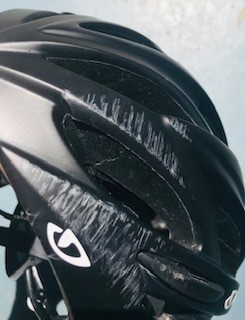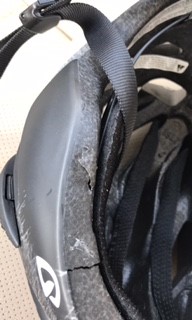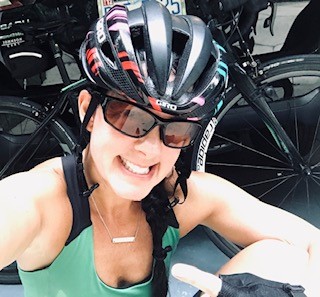Eight years ago, I fell in love with road cycling. You could say that I found myself on those early morning quiet country roads as I pedaled away the mind clutter of the week. Cycling quickly became my meditation in motion.
At the end of a strong 50-mile ride on a gorgeous morning Memorial Day weekend, a half mile from my home, my focus wavered for a second. My front wheel overlapped a rider’s back wheel and I flew over the handlebars at 23 mph.
I felt my head bounce off the asphalt and then the left side of my body sliding on pavement. I reached up to feel for my helmet. My world was spinning.
I soon learned that the road rash down the left arm and leg was the least of my concerns as I struggled to sit up. Over the next 30 minutes, I tried to get to my feet, but failed. I ended up taking an ambulance to the ER for head CT scan. “No skull fractures, but you do have a concussion”, the doctor said. This was the start of a new journey that has extended over the last several months.
All physical activity includes some risk. With cycling, you often hear the stories of collar bone fractures and gnarly road rash. I was aware that crashes do and will eventually happen. I just didn’t know when and, a concussion?
A concussion is defined as a traumatic injury of the brain that temporarily disrupts its normal function. This happens when the brain is moved violently inside the skull due to a direct blow or jolt to the head, face, or neck. Or, as my doctor simply stated, “Think of your head as an egg. Your brain is the yolk, and your egg has been scrambled.”
The immediate symptoms I felt were the ones you will often read about: inability to focus, blurry vision, sensitivity to noise and light, nausea, drowsiness, neck pain, fatigue, and grogginess. These symptoms lasted heavily for 3 weeks.
I spent the first full week at home resting and quickly realized I wasn’t okay. I made an appointment at the Carolina Sports Medicine Concussion Clinic.
For the next month, I was evaluated weekly through a series of balance, coordination, and reaction time-based tests. My doctor explained that to return to my normal physical activity level it would be a multi-step process where intensity and exertion is implemented gradually. He reiterated that my brain was in recovery and was extremely vulnerable to repeat injury. I left each appointment with a structured plan of activity, as well as exercises to do at home that involved eye movement, as well as both walking and ball tossing drills.
While the physical symptoms eventually dissipated, I was left with something unexpected. Feelings of strong, unannounced emotion. Something so small and random could easily bring tears and a difficult day could result in irritability and insomnia. This experience allowed me the opportunity to dive much deeper into my years of yoga training, as I looked to my mat as a safe place for deep breathing, meditation, and recovery. Six months later, I still have days of struggle. It is a process….
At the end of July, I was given the green light to resume my active lifestyle pending my physical symptoms did not reoccur. The first thing I did was order a new helmet fitted with Mips or the multi-directional impact protection system. This system was designed in Sweden in 1996 and has been scientifically proven to reduce rotational motion by absorbing and redirecting forces to the brain upon impact decreasing the risks of brain injury. While a Mips helmet does cost a little more, the investment is well worth it.
Today, I share my story to provide awareness on how to recognize the symptoms of a traumatic brain injury. Through this experience, I’ve gained new knowledge, and while I don’t wish this experience on anyone, it’s important to know the signs of a concussion. Seek the help of a specialist early so you, a family member, a friend, may work with a professional to create a plan to safely return to physical activity. Understand that recovery takes time, everybody responds differently, and you are not alone. There are many resources and support networks in place to help in the recovery process. Here are a few:
- https://concussionfoundation.org/concussion-resourceshttps://www.cdc.gov/traumaticbraininjury/symptoms.html
- https://yogamedicine.com/concussion-recovery-invisible-injury/
You’re probably wondering if I’m back on my bike? You bet!
I now ride with a heightened level of awareness and an overwhelming feeling of gratitude to be able to continue the sport I love.




10 Comments
Thank You Cheryl for your story.
Thank you for enlightening us with your TBI story, Cheryl. I'm very sorry you dealt with this and very glad your recovery was completely successful. This is very eye opening. Thanks for the resources as well.
Thank you for sharing your story, Cheryl. After reading, I reminded all my cycling friends to upgrade to MIPS if they haven't already. Glad you're back on the mend!
Oh my goodness, Cheryl! I had no idea! You are such a strong woman. Thanks for sharing this so others can benefit. You are AWESOME.
Thank you for sharing. Loving cycling as well, I also ride with a feeling of gratitude. So happy for your successful recovery.
Thank you Cheryl for sharing your story. I was not familiar with the Mips helmet, so appreciate that info!
Good gravy, Wheelock. I'm really glad you diligently followed through on recovery. I've had a knock or two on my noggin but nothing so severe. Glad you got back in the saddle.
Cheryl, thank you for this beautiful post. I've already shared it with many and will continue. I appreciate you putting yourself out there and sharing such valuable information with the world. You are super woman!
Cheryl, glad you are feeling better and back on the saddle seat. I feel your pain. I suffered a TBI in a major car accident. Unlike a broken bone or a road-rash, you cannot see a TBI. It can be very frustrating which only makes the symptoms worse. Meditation was the key to my own recovery, and I highly recommend it. I'll definitely be sharing your story and encouraging others to take precaution and recognize the signs of concussion and TBI.
More power to you, Cheryl! Glad to hear that you recovered well. Live strong!